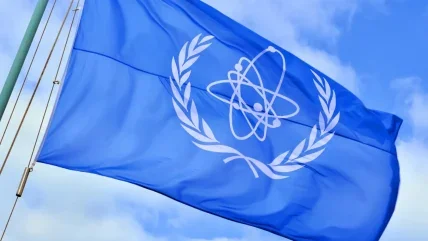
The nuclear safety conditions at Ukraine’s Zaporizhzhya Nuclear Power Plant (ZNPP) are worsening after a drone strike, which impacted the road surrounding the plant’s perimeter, according to International Atomic Energy Agency (IAEA) Director General Rafael Mariano Grossi.
Grossi said: “Yet again we see an escalation of the nuclear safety and security dangers facing the Zaporizhzhya Nuclear Power Plant. I remain extremely concerned and reiterate my call for maximum restraint from all sides and for strict observance of the five concrete principles established for the protection of the plant.”
Earlier today, the IAEA Support and Assistance Mission to Zaporizhzhya (ISAMZ) team was notified by ZNPP that a drone had dropped an explosive just outside the plant’s protected area. The explosion occurred near the critical cooling water sprinkler ponds and approximately 100m from the Dniprovska power line, the sole remaining 750-kilovolt (kV) line supplying power to the ZNPP.
The team promptly inspected the area and confirmed that the damage appeared to be caused by a drone carrying an explosive payload. Fortunately, there were no casualties, and no nuclear plant equipment was affected. However, the explosion did damage the road between the two main gates of the ZNPP.
The ISAMZ team has also noted that military activity in the region, including very close to the plant, has been intense over the past week. The team has frequently heard explosions, as well as continuous heavy machine gun and rifle fire, and artillery at varying distances from the plant. Despite Director General Grossi’s repeated calls for restraint, there is no indication that the military activity near the ZNPP is diminishing.
On 10 August, ZNPP informed the IAEA team that artillery had struck the local power and water substation in Enerhodar, the city where most ZNPP staff reside. The attack resulted in the failure of two transformers, causing a citywide power outage, which forced water to be supplied using diesel generators. However, by 11 August, ZNPP informed the IAEA team that power had been restored in the city.
Earlier this week, a significant fire at one of ZNPP’s cooling towers caused substantial damage, though there was no immediate threat to nuclear safety.
Additionally, IAEA teams stationed at the Khmelnytskyy, Rivne, and South Ukraine NPPs, as well as the Chornobyl site, have reported frequent air raid alarms and drone attacks throughout the week.
This week, Director General Grossi continued discussions regarding recent events within the Russian Federation, particularly concerning the proximity of military activity to a significant and operational nuclear power plant. He has expressed his willingness to assess the situation firsthand, including the possibility of visiting the plant.






